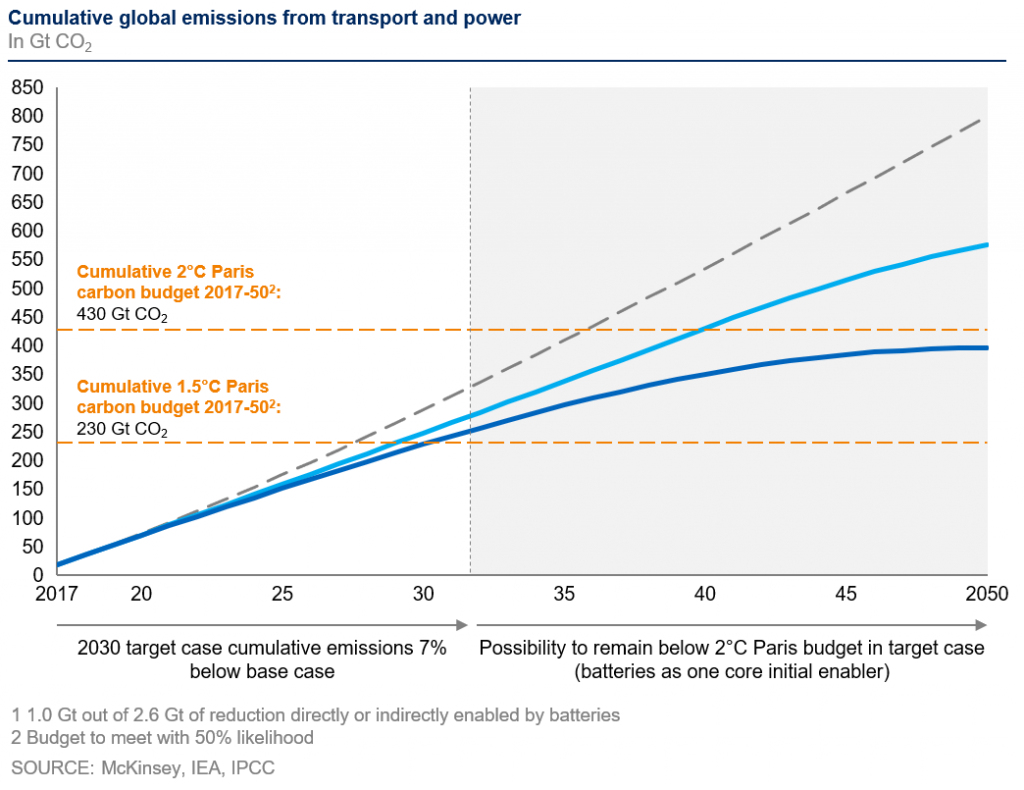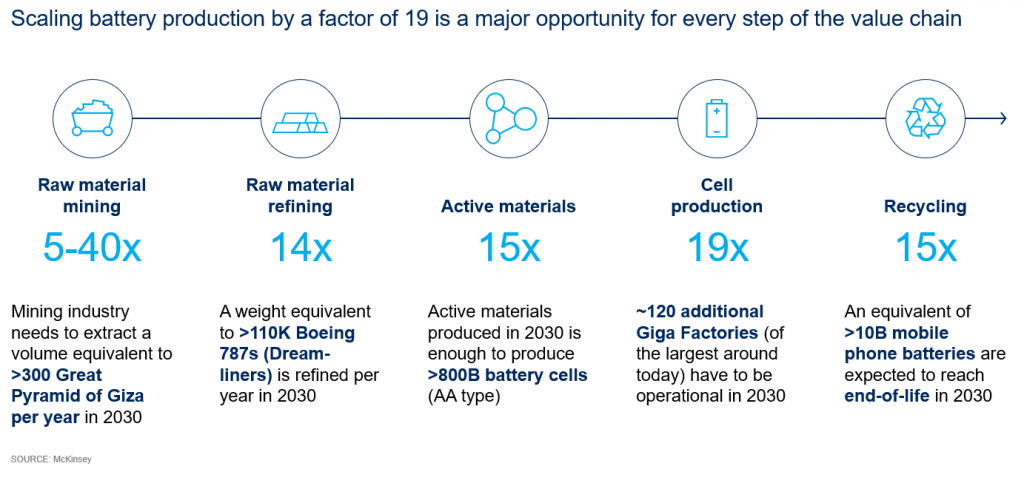Sustainable Batteries Represent Best Prospect For Meeting Paris Climate Goals
Advances in the production, use and reuse of batteries mean that the technology could become the most significant intervention to keep global warming within the limits set by the Paris Agreement on climate change between now and 2030, according to a report published Thursday.
The report, which was commissioned by the Global Battery Alliance, a public-private partnership led by the World Economic Forum, says that, with a concerted push to put the right conditions in place, batteries could enable a 30% reduction in carbon emissions in both the transport and power sectors. These two sectors alone collectively account for 40% of all greenhouse gas emissions today.
Such a reduction in emissions would help keep the world within its 2°C Paris Agreement goal, the report finds. It requires immediate action along the battery value chain alongside investments in other technologies such as hydrogen and in other industries. This would also contribute to achieving the more ambitious 1.5° goal of the Paris Agreement’s, the report concludes.

In addition to examining the role batteries could play in helping to tackle climate change, the report finds that wider economic and societal benefits could also be accrued from systemically investing in the entire battery value chain from mining to reuse or recycling. In terms of employment, 10 million high-quality jobs would be created. More than half of these would be in emerging economies. Additionally, 600 million people would be provided with electricity for the first time. This would close the world’s existing energy access gap by 70%.
“Reducing the world’s carbon footprint is the defining challenge of the 21st century. For the next 10 years, modern batteries that are powering the 4th industrial revolution represent the greatest prospect for reducing atmospheric pollution from many of our most energy intensive economic activities,” said Dominic Waughray, Head of the Platform for Global Public Goods and Managing Director at the World Economic Forum.
Scaling up responsibly
Achieving the scale to make these goals achievable requires considerable change, the report finds. Firstly, today’s global battery value chain would have to expand 19 times the size it is today. This would require $550 billion of cumulative investments along the entirety of the value chain over the next 10 years, along with a set of targeted interventions. These could for example increase the productivity with which batteries are used, lower effective battery costs and cut greenhouse gas emissions along the battery value chain by close to 50% putting it on track to achieving net-zero emissions in 2050.
“We need to develop a sustainable, circular and low carbon value chain for batteries to contribute to the implementation of the 2015 Paris Climate Agreement and to reach the UN Sustainable Development Goals. But this task can only be achieved by effective cooperation between businesses, international organizations, governments and civil society,” said Martin Brudermüller, Chairman of the Board of Executive Directors of BASF and Co-Chair of the Global Battery Alliance.
Secondly, it would necessitate a huge expansion in mining: annual extraction of minerals by 2030 would weigh more than 300 Great Pyramids of Giza. Some 120 additional battery state-of-the-art factories would also need to be operational to meet required demand.

Most importantly, a structural shift would be required to make batteries sustainable from an environmental and human perspective. This includes making sure the entire value chain is “circular”, whereby batteries are reused, repurposed or recycled at the end of their life cycle or simply used more efficiently. For example, integrating battery-powered vehicles into the electricity grid at scale could cover 65% of demand for stationary battery storage and enable a higher renewable energy share in power grids globally, the report finds. Moreover, in 2030 recycling could provide 13% of global demand for cobalt, 5% of nickel and 9% of lithium. These shares are expected to grow as the volume of batteries reaching their end of life surge after 2030.
Furthermore, sustainable business operations must be enabled by boosting the share of renewable energy in the value chain. Finally, a more responsible value chain can be created through better business performance on established sustainability norms backed by traceability systems and effective local interventions to protect human rights, reduce and eliminate child or forced labour and boost local economic value creation. To this end, the Global Battery Alliance will publish and begin implementing in 2019 a roadmap of actions to reduce and eradicate child labour over the coming decade.
Course correction required
The potential for batteries to significantly reduce the world’s carbon footprint, create jobs, improve energy access and working conditions for those working in the industry will not be realized if the value chain develops along its current trajectory, the report finds.
While the battery value chain is expected to grow annually by 25% over the next decade, this level of growth will not be sufficient to help meet the Paris Agreement goals. Without focusing on waste and workers, such uncoordinated growth could even place more environmental and societal strain on our world.
To avoid such an outcome, the Global Battery Alliance today calls on all stakeholders to adhere to [10 recommendations] aimed at building a circular, sustainable and responsible value chain. The GBA plans to engage all stakeholders to develop an implementation strategy to realize this opportunity.
Analytical support for this report was provided by McKinsey & Company, with additional work carried out on circular economy dimensions by SYSTEMIQ.
“Cost-efficient and sustainable batteries are one major driver to decarbonize road transportation as automakers will launch more than 300 battery electric vehicle models in the next five years. Around 70 bn USD additional value can be created by designing batteries for the full lifecycle and building businesses around vehicle-to-grid, second use, and recycling. The mobility transition requires new industry coalitions including the regulators – and it needs them now,” said Bernd Heid, Senior Partner, McKinsey & Company, Inc.
“The demand for raw materials to fuel the battery revolution often poses risks such as child and forced labour, unsafe working conditions and pollution. It is critical that all stakeholders come together to take collective action. Increased investments to improve living conditions, tackle the root causes of child labour and to strengthen systems in the communities can ensure that global efforts to reduce the world’s carbon footprint do not create unintended consequences for the world’s most vulnerable populations,” said Charlotte Petri Gornitzka, Deputy Executive Director at the United Nations Children’s Fund (UNICEF).”

